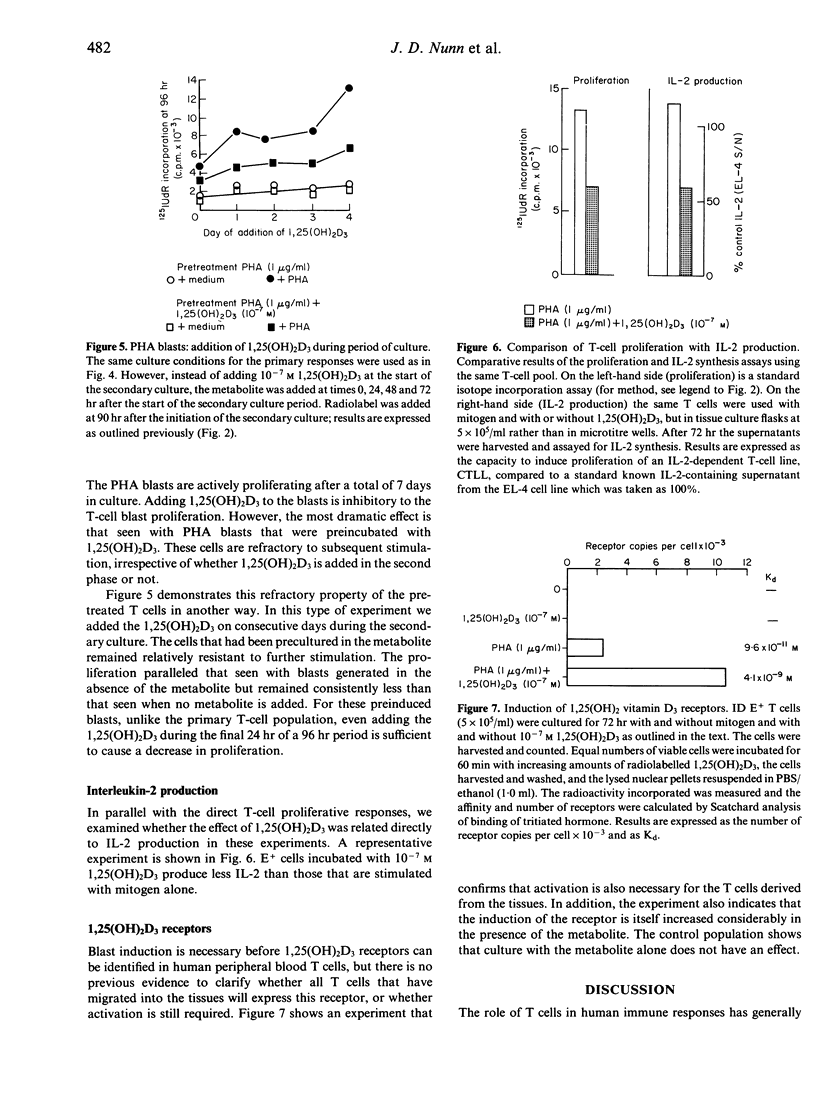Abstract
We have examined the effects of 1,25(OH)2D3 on T-cell populations isolated by buoyant density and E rosetting from human tonsils. Cell proliferation was assessed by measuring the incorporation of 125iododeoxyuridine; interleukin-2 (IL-2) production was measured using an IL-2-dependent cell line, and the number of 1,25(OH)2D3 receptors was measured by whole-cell nuclear association assay. At a concentration of 10(-7) M, 1,25(OH)2D3 inhibited mitogen-induced T-cell proliferation in all E+ T-cell populations. This effect was more pronounced in the cells from the intermediate and high density layers and was reflected both in cell proliferative responses and in relative IL-2 synthesis. By adding the 1,25(OH)2D3 during the course of the mitogen assay, we demonstrated that activation of the T cell precedes the 1,25(OH)2D3-mediated inhibition. Cells that had been preincubated with mitogen in the presence of the 1,25(OH)2D3 were refractory to further stimulation by mitogens. Receptors for 1,25(OH)2D3 could not be detected in unstimulated T cells. However, activation led to the expression of high-affinity receptors for 1,25(OH)2D3. Co-incubation of the cells with mitogen and 1,25(OH)2D3 increased the number of receptors compared with mitogen alone. The effects provide further evidence for the hypothesis that 1,25(OH)2D3 is an important potential modulator of the immune system through its action on T cells. Taking our observations in conjunction with the known capacity of monocytes to hydroxylate the precursor metabolite (and thus synthesize the active form of cholecalciferol), the results support the suggestion that 1,25(OH)2D3 plays a role as a local mediator of mononuclear phagocyte-T cell interaction in human lymphomedullary tissues.
Full text
PDF





Selected References
These references are in PubMed. This may not be the complete list of references from this article.
- Adams J. S., Gacad M. A. Characterization of 1 alpha-hydroxylation of vitamin D3 sterols by cultured alveolar macrophages from patients with sarcoidosis. J Exp Med. 1985 Apr 1;161(4):755–765. doi: 10.1084/jem.161.4.755. [DOI] [PMC free article] [PubMed] [Google Scholar]
- Bhalla A. K., Amento E. P., Serog B., Glimcher L. H. 1,25-Dihydroxyvitamin D3 inhibits antigen-induced T cell activation. J Immunol. 1984 Oct;133(4):1748–1754. [PubMed] [Google Scholar]
- Clemens T. L., Hendy G. N., Graham R. F., Baggiolini E. G., Uskokovic M. R., O'Riordan J. L. A radioimmunoassay for 1,25-dihydroxycholecalciferol. Clin Sci Mol Med. 1978 Mar;54(3):329–332. doi: 10.1042/cs0540329. [DOI] [PubMed] [Google Scholar]
- Cohen M. S., Gray T. K. Phagocytic cells metabolize 25-hydroxyvitamin D3 in vitro. Proc Natl Acad Sci U S A. 1984 Feb;81(3):931–934. doi: 10.1073/pnas.81.3.931. [DOI] [PMC free article] [PubMed] [Google Scholar]
- Geha R. S., Merler E. Response of human thymus-derived (T) and non-thymus-derived (B) lymphocytes to mitogenic stimulation in vitro. Eur J Immunol. 1974 Mar;4(3):193–199. doi: 10.1002/eji.1830040308. [DOI] [PubMed] [Google Scholar]
- Hahn H., Kaufmann S. H. The role of cell-mediated immunity in bacterial infections. Rev Infect Dis. 1981 Nov-Dec;3(6):1221–1250. doi: 10.1093/clinids/3.6.1221. [DOI] [PubMed] [Google Scholar]
- Parish C. R., McKenzie I. F. A sensitive rosetting method for detecting subpopulations of lymphocytes which react with alloantisera. J Immunol Methods. 1978;20:173–183. doi: 10.1016/0022-1759(78)90254-5. [DOI] [PubMed] [Google Scholar]
- Reitsma P. H., Rothberg P. G., Astrin S. M., Trial J., Bar-Shavit Z., Hall A., Teitelbaum S. L., Kahn A. J. Regulation of myc gene expression in HL-60 leukaemia cells by a vitamin D metabolite. Nature. 1983 Dec 1;306(5942):492–494. doi: 10.1038/306492a0. [DOI] [PubMed] [Google Scholar]
- Sunshine G. H., Katz D. R., Feldmann M. Dendritic cells induce T cell proliferation to synthetic antigens under Ir gene control. J Exp Med. 1980 Dec 1;152(6):1817–1822. doi: 10.1084/jem.152.6.1817. [DOI] [PMC free article] [PubMed] [Google Scholar]


